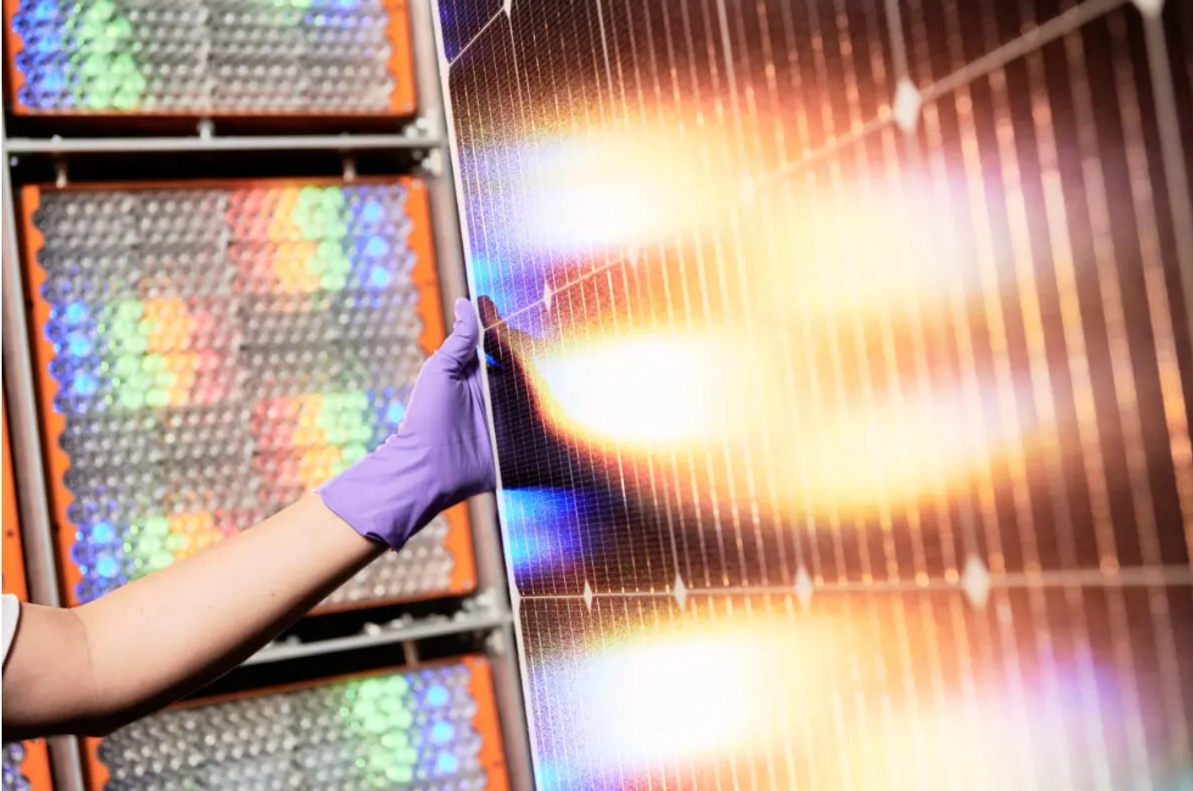Oxford PV, Fraunhofer ISE achieve ‘record-breaking efficiency’ for PV module
Solar cell developer Oxford PV and Fraunhofer ISE have successfully developed a full-sized tandem PV module with a record efficiency of 25%.

Oxford PV set a ‘new world record’ for the efficiency of a commercial-sized solar cell last year. Image: Fraunhofer ISE.
Solar cell developer Oxford PV and Fraunhofer ISE have successfully developed a full-sized tandem PV module with a record efficiency of 25%.
Using the Oxford PV perovskite-silicon tandem solar cells, a research team at Fraunhofer ISE has successfully manufactured a glass-glass tandem PV module with 25% efficiency (related to designated illuminated area).
The record-breaking cell achieved an output of 421 watts on an area of 1.68 metres. This makes it the “world’s most efficient silicon perovskite tandem solar module in industrial format”, the companies declared.
According to a statement released by the two organisations, the PV modules, which are based on perovskite silicon tandem solar cells, could have a greater efficiency rating in comparison to standard silicon PV modules. Interestingly, silicon tandem cells have a theoretical maximum efficiency of over 43% compared to less than 30% for silicon solar cells.
“This new world record is a crucial milestone for Oxford PV, proving that our tandem solar cells can deliver record-breaking performance when assembled into solar panels,” said David Ward, CEO of Oxford PV.
Prof. Dr. Stefan Glunz, head of photovoltaics at Fraunhofer ISE highlighted the mass-production potential of the technology. Glunz said: “The fact that mass production-compatible technology was used for its manufacture demonstrates the enormous potential of tandem technology for the PV industry.”
The Fraunhofer research team developed low-temperature processes for interconnection and encapsulation of solar cells. This is a gentle operation and thus enables the cells to be more efficient.
Dr. Achim Kraft, group leader for Interconnection Technology at Fraunhofer ISE said that the solar cells were interconnected using conductive bonding. “This type of interconnection is used on an industrial scale at Fraunhofer ISE’s Module-TEC. In future, we will also be testing another alternative: soldering the solar cells at low temperatures,” said Dr. Achim Kraft.
For the calibration measurements, CalLab PV Modules used a new multispectral solar simulator to determine the module efficiency. The two organisations are now working towards certification of the PV module.
Oxford PV continues to break records
Regular readers of Solar Power Portal will remember that Oxford PV set a ‘new world record’ for the efficiency of a commercial-sized solar cell last year. The record-breaking solar cell converted 28.6% of the sun’s energy into electricity, as independently certified by Fraunhofer ISE. This was considered a major breakthrough for the wider solar industry and could help create more efficient solar panels.
Oxford PV created the record-breaking solar cell by depositing a thin film of the material perovskite onto a conventional silicon solar cell. The organisation stated that “the combined ‘perovskite-on-silicon’ tandem solar cell achieves a conversion efficiency that is substantially higher than that of mainstream silicon-only solar cells, which average 22–24%”.
Solar Power Portal caught up with Dr Chris Case, chief technology officer (CTO) at Oxford PV, to find out more about the company’s record-breaking technology and its future growth plans.
Recent Posts
-
Oxford PV, Fraunhofer ISE achieve ‘record-breaking efficiency’ for PV module
Solar cell developer Oxford PV and Fraunhofer ISE have successfully developed a full-sized tandem PV …1st Feb 2024 -
New research shows impact of dust on PV module temperature, performance
New research from Pakistan shows that dust could reduce PV panel performance through the shielding e …1st Feb 2024 -
Chinese PV Industry Brief: JinkoSolar, Arctech unveil 2023 earnings forecasts
JinkoSolar says it expects a 2023 net profit ranging between CNY 7.25 billion ($1.02 billion) and CN …1st Feb 2024




